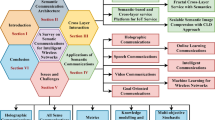Abstract
This paper examines the relative importance of wavelength conversion and time‐slot interchange in improving the performance of multiwavelength time‐division multiplexed networks. It is shown that, in networks with a small number of wavelengths, each carrying a large number of time‐division multiplexed channels, significant performance improvements are achieved by the introduction of time‐slot interchange alone, without wavelength conversion. However, some performance improvements are also achieved by the introduction of wavelength conversion alone.
Similar content being viewed by others
References
R. Barry and P. Humblet, Models of blocking probability in all-optical networks with and without wavelength changers, IEEE Journal on Selected Areas in Communications 14(5) (1996) 858–867.
A. Birman, Computing approximate blocking probabilities for a class of all-optical networks, IEEE Journal on Selected Areas in Communications 14(5) (1996) 852–857.
E. Brockmeyer, H.A. Hallstrøm and A. Jensen, The life and works of A.K. Erlang, Translation of the Danish Academy of Technological Sciences, No 2 (1948).
R.B. Cooper, Introduction to Queueing Theory(Macmillan, New York, 1972).
A. Girard, Routing and Dimensioning in Circuit-Switched Networks(Addison-Wesley, Reading, MA, 1990).
G.R. Hill et al., A transport network layer based on optical network elements, Journal of Lightwave Tech. 11(5/6) (1993) 667–679.
D. Hunter, I. Andonovic and P. Barnsley, Demonstration of optical timeslot interchanging through 2 x 2 crosspoints and feedforward delay line, IEE Electron. Letters 30(11) 875–876.
C. Joergensen, T. Durguus, C. Braagaard, B. Mikkelsen and K.E. Stubkjaer, 4 Gb/s optical wavelength conversion using semiconductor optical amplifiers, IEEE Photon. Tech. Letters 5(6) (1993) 657–670.
S. Kawanishi, H. Takara, O. Kamatani and T. Morioka, 100 Gbit/s, 500 km optical transmission experiment, IEE Electron. Letters 31(9) (1995) 737–738.
N. Khrais, A. Elrefaie and R. Wagner, Performance degradations of WDM systems due to laser and optical filter misalignments, IEE Electron. Letters 31(14) (1995) 1179–1180.
L. Kleinrock, Queueing Systems, Vol. 1: Theory(Wiley, New York, 1975).
M. Kovačević and A. Acampora, On wavelength translation in all-optical networks, in: Proc.of IEEE INFOCOM '95, Vol. 2, Boston, MA (April 1995) pp. 413–422.
M. Kovačević and A. Acampora, Benefits of wavelength translation in all-optical clear-channel networks, IEEE Journal on Selected Areas in Communications 14(5) (1996) 868–880.
K.C. Lee and V. Li, A wavelength-convertible optical network, Journal of Lightwave Tech. 11(5/6) (1993) 962–970.
B. Mikkelsen, T. Durhuus, C. Joergensen, R. Pedersen, C. Braagaard and K. Stubkjaer, Polarisation insensitive wavelength conversion of 10 Gbit/s signals with SOAs in a Michelson interferometer, IEE Electron. Letters 30(3) 260–261.
R. Ramaswami and K. Sivarajan, Optimal routing and wavelength assignment in all-optical networks, in: Proc.of IEEE INFOCOM '94, Vol. 1, Toronto, Canada (June 1994) pp. 110–119.
M. Sabry and J. Midwinter, Towards an optical ether, IEE Proc. Journal 141(5) (1994) 327–335.
S. Subramaniam and R.A. Barry, Wavelength assignment in fixed routing WDM networks, in: Proc.of the IEEE Internat.Conf.on Communications ICC '97, Montréal, Canada (June 1997) pp. 406–410.
A Course in Teletraffic Engineering(Telecom Australia, 1978).
N. Wauters and P. Demeester, Wavelength translation in optical multi-wavelength multi-fibre transport networks, International Journal of Optoelectronics 11(1) (1997) 53–70.
J. Yao, P. Barnsley, N. Walker and M. O'Mahony, Time slot interchanging using semiconductor laser amplifiers, IEE Electron. Letters 29(12) 1053–1054.
J. Yates, Performance analysis of dynamically-reconfigurable wavelength-division multiplexed networks, Ph.D. thesis, The University of Melbourne, Australia (1997).
J. Yates, J. Lacey and D. Everitt, Blocking in multiwavelength TDM networks, in: Proc.of the 4th Internat.Conf.on Telecommunication Systems Modelling and Analysis, Nashville, USA (March 1996) pp. 535–541.
J. Zhou, M.J. O'Mahony and S.D. Walker, Analysis of optical crosstalk effects in multi-wavelength switched networks, IEEE Photon. Tech. Letters 6(2) (1994) 302–305.
J. Zhou, N. Park, K. Vahala, M. Newkirk and B. Miller, Four-wave mixing wavelength conversion efficiency in semiconductor traveling-wave amplifiers measured to 65 nm of wavelength shift, IEEE Photon. Tech. Letters 6(8) (1994) 984–987.
Author information
Authors and Affiliations
Rights and permissions
About this article
Cite this article
Yates, J., Lacey, J. & Everitt, D. Blocking in multiwavelength TDM networks. Telecommunication Systems 12, 1–19 (1999). https://doi.org/10.1023/A:1019126108153
Issue Date:
DOI: https://doi.org/10.1023/A:1019126108153




